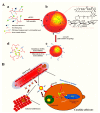Nanomaterials for the Diagnosis and Treatment of Urinary Tract Infections
- PMID: 33671511
- PMCID: PMC7926703
- DOI: 10.3390/nano11020546
Nanomaterials for the Diagnosis and Treatment of Urinary Tract Infections
Abstract
The diagnosis and treatment of urinary tract infections (UTIs) remain challenging due to the lack of convenient assessment techniques and to the resistance to conventional antimicrobial therapy, showing the need for novel approaches to address such problems. In this regard, nanotechnology has a strong potential for both the diagnosis and therapy of UTIs via controlled delivery of antimicrobials upon stable, effective and sustained drug release. On one side, nanoscience allowed the production of various nanomaterial-based evaluation tools as precise, effective, and rapid procedures for the identification of UTIs. On the other side, nanotechnology brought tremendous breakthroughs for the treatment of UTIs based on the use of metallic nanoparticles (NPs) for instance, owing to the antimicrobial properties of metals, or of surface-tailored nanocarriers, allowing to overcome multidrug-resistance and prevent biofilm formation via targeted drug delivery to desired sites of action and preventing the development of cytotoxic processes in healthy cells. The goal of the current study is therefore to present the newest developments for the diagnosis and treatment of UTIs based on nanotechnology procedures in relation to the currently available techniques.
Keywords: diagnosis; multidrug resistance; surface-tailored nanomedicines; therapy; urinary tract infections.
Conflict of interest statement
The authors declare no conflict of interest.
Figures



Similar articles
-
Current issues in the management of urinary tract infections: extended-release ciprofloxacin as a novel treatment option.Drugs. 2004;64(6):611-28. doi: 10.2165/00003495-200464060-00004. Drugs. 2004. PMID: 15018591 Review.
-
Emerging nanotechnology based strategies for diagnosis and therapeutics of urinary tract infections: A review.Adv Colloid Interface Sci. 2017 Nov;249:53-65. doi: 10.1016/j.cis.2017.06.010. Epub 2017 Jun 26. Adv Colloid Interface Sci. 2017. PMID: 28668171 Review.
-
Extended-release ciprofloxacin (Cipro XR) for treatment of urinary tract infections.Int J Antimicrob Agents. 2004 Mar;23 Suppl 1:S54-66. doi: 10.1016/j.ijantimicag.2003.12.005. Int J Antimicrob Agents. 2004. PMID: 15037329 Review.
-
Biofilm-producing potential of urinary pathogens isolated from chronic and recurrent urinary tract infections and impact of biofilm on gentamicin and colistin in vitro efficacy.Epidemiol Mikrobiol Imunol. 2020 Winter;69(1):3-9. Epidemiol Mikrobiol Imunol. 2020. PMID: 32326710 English.
-
Role of fluoroquinolones in the treatment of serious bacterial urinary tract infections.Drugs. 2004;64(12):1359-73. doi: 10.2165/00003495-200464120-00007. Drugs. 2004. PMID: 15200349 Review.
Cited by
-
Nanotechnology Involved in Treating Urinary Tract Infections: An Overview.Nanomaterials (Basel). 2023 Jan 30;13(3):555. doi: 10.3390/nano13030555. Nanomaterials (Basel). 2023. PMID: 36770516 Free PMC article. Review.
-
Ciprofloxacin-Releasing ROS-Sensitive Nanoparticles Composed of Poly(Ethylene Glycol)/Poly(D,L-lactide-co-glycolide) for Antibacterial Treatment.Materials (Basel). 2021 Jul 24;14(15):4125. doi: 10.3390/ma14154125. Materials (Basel). 2021. PMID: 34361319 Free PMC article.
-
Morphologic Design of Silver-Bearing Sugar-Based Polymer Nanoparticles for Uroepithelial Cell Binding and Antimicrobial Delivery.Nano Lett. 2021 Jun 23;21(12):4990-4998. doi: 10.1021/acs.nanolett.1c00776. Epub 2021 Jun 11. Nano Lett. 2021. PMID: 34115938 Free PMC article.
-
Novel Antimicrobial Approaches to Combat Bacterial Biofilms Associated with Urinary Tract Infections.Antibiotics (Basel). 2024 Feb 4;13(2):154. doi: 10.3390/antibiotics13020154. Antibiotics (Basel). 2024. PMID: 38391540 Free PMC article. Review.
-
Nanotechnology in Bladder Cancer: Diagnosis and Treatment.Cancers (Basel). 2021 May 5;13(9):2214. doi: 10.3390/cancers13092214. Cancers (Basel). 2021. PMID: 34063088 Free PMC article. Review.
References
Publication types
Grants and funding
LinkOut - more resources
Full Text Sources
Other Literature Sources

